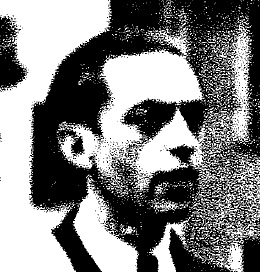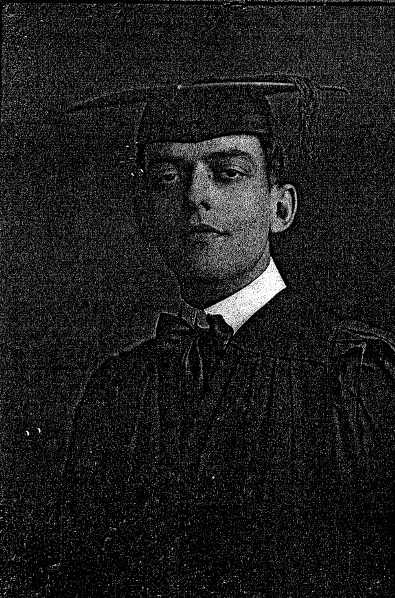
Fr. Kyrill Johnson, 1930. This is the only photo I've seen of Johnson taken while he was an Orthodox priest. (Ipswich Historical Society)
A lot of us at SOCHA happen to be really busy right now (personally, I’m in the middle of law school exams), so rather than leave you without much to read this week, here’s an article we originally published back in August 2010.
Fr. Kyrill Johnson was one of many fascinating early American converts to Orthodoxy. He was born Arthur Warren Johnson in Roxbury, Massachusetts in 1897. I don’t know what happened to his parents, but Johnson was adopted by an unmarried aunt, who raised him in Ipswich. He went to college at William and Mary in Virginia, which is probably where he first encountered the Orthodox Church. One of his classmates was a fellow named Royce Burden, and both were almost certainly students of young Professor Michael Gelsinger.
Arthur Johnson graduated in 1921. The next year, both Burden and Gelsinger were ordained Orthodox priests and assigned to serve in the “English-speaking department” of the Russian Archdiocese. This “department” had its origins in 1905, when Fr. Ingram Nathaniel Irvine converted to Orthodoxy and was charged by St. Tikhon to do “English work.” Irvine died in early 1921, by which point another convert priest, Fr. Patrick Mythen, had taken over the English-speaking department. Mythen brought numerous Americans into the Orthodox Church, but he was wayward and immature, and many of his converts (along with Mythen himself) ultimately left the Church.
I don’t know what role Mythen played in the conversions of Burden, Gelsinger, and Arthur Johnson, but that trio, unlike so many of their fellow 1920s converts, remained in the Church for the rest of their lives. I don’t know exactly when Johnson was ordained, but he was definitely a priest by 1924. The next year, he earned a Master’s degree from Harvard Divinity School.
Johnson — by now Fr. Kyrill — was a celibate priest, and he doesn’t seem to have had a parish in the 1920s. He may have been under the jurisdiction of Archbishop Aftimios Ofiesh, who oversaw the English-speaking department (and the American Orthodox Catholic Church, into which the English department morphed), but Johnson’s focus, in those years, seems to have been scholarly pursuits. In the mid-’20s, he was a key part of Harvard expeditions to Mount Athos and Mount Sinai, searching for ancient Biblical manuscripts. He also spent time in Syria, where he discovered rare proto-Semitic inscriptions.
In the early 1930s, Johnson was back in Ipswich, where he published several books on local history. In 1938, he became pastor of St. George Antiochian church in nearby Lawrence, Mass. — as far as I can tell, this was his first parish assignment in at least 14 years as an Orthodox priest. In 1940, he took on another job, becoming the head of the Society for the Preservation of New England Antiquities. The organization, which today has the more palatable name “Historic New England,” owns and preserves historic homes and other buildings in New England. The next year, 1941, Metropolitan Antony Bashir elevated Johnson to archimandrite. Johnson lived only six more years, dying in 1947, at the age of just 50.
So far, I’ve basically given you a dry biography of Fr. Kyrill Johnson. What sort of person was he, though? Pat Tyler of the Ipswich Historical Society happened to know Johnson when she was young. A few years ago, she told me, “He lived across the street from me — to the Yankees in town, he was just ‘strange,’ in that black robe.” Later, she added, “I knew him in the 30’s just as the guy across the street – I was just a child. My mother, of course, knew him. She and her friend, Helen, actually spent the night at the beach (Crane’s) with Arthur. I picture the scene as teenagers spouting Shakespeare. And Platonic to the max.”
Here’s another account of Johnson, from the book Becoming What One Is, by Austin Warren: “Friends brought acquaintances; and I remember […] Arthur Johnson of Ipswich, a swarthy, lean, Byzantine-looking bachelor, who, a pure Yankee and reared a Methodist, had become (after an Anglican interlude) an ordained deacon in the Greek Orthodox Church.”

Arthur Johnson's graduation photo from the College of William and Mary, 1921 (Ipswich Historical Society)
Back in college, Johnson’s class elected him “most eccentric man.” He was extremely involved in his school activities — class historian, student council secretary, associate editor of the student newspaper, editor-in-chief of the college literary magazine. He was in a drama club, manager of the debate council… I could go on, but I think you get the point. He never married, of course, and I get the sense that nobody who knew him was surprised by this fact. He was odd, friendly, bookish. He was also a talented writer.
Of the three William and Mary converts — Johnson, Burden, and Gelsinger — Johnson was clearly the least well-known, and probably the least influential. But he lived a fascinating life, and stands out as one of the few convert priests of the 1920s who remained in the Orthodox Church until the day he died.
For more information on Fr Johnson, pl are see this website. We have a memorial service at his grave every year. http://stgeorgelawrence.org/wp-content/uploads/2018/06/frj.pdf
Thank you! This is great!
The link posted by Mat. Anna Timko Hughes has been changed and the info can now be found here! https://stgeorgelawrence.org/about-our-parish/history